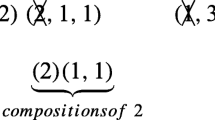Abstract
The randomness rate of an infinite binary sequence is characterized by the sequence of ratios between the Kolmogorov complexity and the length of the initial segments of the sequence. It is known that there is no effective procedure that transforms one input sequence into another sequence with higher randomness rate. By contrast, we display such a uniform effective procedure having as input two independent sequences with positive but arbitrarily small constant randomness rate. Moreover the transformation is a truth-table reduction and the output has randomness rate arbitrarily close to 1.
Similar content being viewed by others
References
Barak, B., Impagliazzo, R., Wigderson, A.: Extracting randomness using few independent sources. In: Proceedings of the 36th ACM Symposium on Theory of Computing, pp. 384–393 (2004)
Bienvenu, L., Doty, D., Stephan, F.: Constructive dimension and weak truth-table degrees. In: Computation and Logic in the Real World—Third Conference of Computability in Europe. Lecture Notes in Computer Science, vol. 4497, pp. 63–72. Springer, Berlin (2007)
Buhrman, H., Fortnow, L., Newman, I., Vereshchagin, N.: Increasing Kolmogorov complexity. In: Proceedings of the 22nd Annual Symposium on Theoretical Aspects of Computer Science. Lecture Notes in Computer Science, vol. 3404, pp. 412–421. Springer, Berlin (2005)
Calude, C., Zimand, M.: Algorithmically independent sequences. In: Developments in Language Theory. Lecture Notes in Computer Science, vol. 5257, pp. 183–195. Springer, Berlin (2008)
Doty, D.: Dimension extractors and optimal decompression. Theory Comput. Syst. 43(3–4), 425–463 (2008)
Fortnow, L., Hitchcock, J., Pavan, A., Vinodchandran, N.V., Wang, F.: Extracting Kolmogorov complexity with applications to dimension zero-one laws. In: Proceedings of the 33rd International Colloquium on Automata, Languages, and Programming. Lecture Notes in Computer Science, vol. 4051, pp. 335–345. Springer, Berlin (2006)
Lutz, J.: The dimensions of individual strings and sequences. Inf. Control 187, 49–79 (2003)
Mayordomo, E.: A Kolmogorov complexity characterization of constructive Hausdorff dimension. Inf. Process. Lett. 84, 1–3 (2002)
Miller, J.: Extracting information is hard: a Turing degree of non-integral effective Hausdorff dimension. Adv. Math. (2008, to appear). Manuscript available at http://www.math.uconn.edu/~josephmiller/Papers/dimension.pdf
Nies, A., Reimann, J.: A lower cone in the wtt degrees of non-integral effective dimension. In: Proceedings of IMS Workshop on Computational Prospects of Infinity, Singapore (2006, to appear)
Reimann, J.: Computability and fractal dimension. Technical report, Universität Heidelberg (2004). Ph.D. thesis
Ryabko, B.: Coding of combinatorial sources and Hausdorff dimension. Dokl. Akad. Nauk SSR 277, 1066–1070 (1984)
Shen, A.: Algorithmic information theory and Kolmogorov complexity. Technical Report 2000-034, Uppsala Universitet (December 2000)
Staiger, L.: Constructive dimension equals Kolmogorov complexity. Inf. Process. Lett. 93, 149–153 (2005) Preliminary version: Research Report CDMTCS-210, Univ. of Auckland (January 2003)
Zimand, M.: Computational Complexity: A Quantitative Perspective. North-Holland Mathematics Studies, vol. 196. Elsevier, Amsterdam (2004)
Zimand, M.: Extracting the Kolmogorov complexity of strings and sequences from sources with limited independence. In: Albers, S., Marion, J.-Y. (eds.) Proceedings 26th STACS, Freiburg, Germany, February 26–29, 2009, pp. 697–708
Author information
Authors and Affiliations
Corresponding author
Additional information
The author is supported by NSF grant CCF 0634830. Part of this work was done while visiting University of Auckland, New Zealand.
Rights and permissions
About this article
Cite this article
Zimand, M. Two Sources Are Better than One for Increasing the Kolmogorov Complexity of Infinite Sequences. Theory Comput Syst 46, 707–722 (2010). https://doi.org/10.1007/s00224-009-9214-6
Received:
Accepted:
Published:
Issue Date:
DOI: https://doi.org/10.1007/s00224-009-9214-6




